A.R. Pardington: “The Modern Appian Way for the Motorist”- The 1907 Pitch for the Motor Parkway
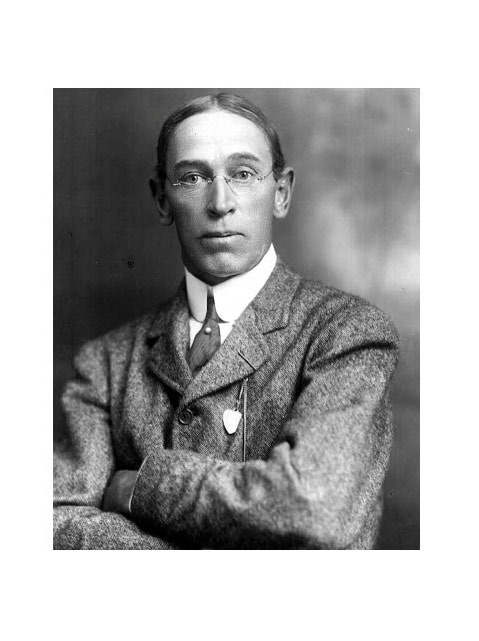
In November 1906, A.R. Pardington became the primary salesman for the planned Motor Parkway when he was elected general manager and second vice-president by the Long Island Motor Parkway, Inc. Pardington traveled from village to village promoting its benefits to Long Island. His sales pitch was captured in this article "The Modern Appian Way for the Motorist" published in Harper's Weekly on March 16, 1907.
I have highlighted Pardington's key points in the article.
Transcription wasprovided by Marshall Davies Lloyd, who has posted several wonderful articles on A.R. Pardington.
Enjoy,
Howard Kroplick
THE MODERN APPIAN WAY FOR THE MOTORIST
THE PROTECTED AUTOMOBILE PARKWAY ON LONG ISLAND WHICH WILL GIVE THE MOTORIST A CONTINUOUS BOULEVARD NINETY MILES LONG AND FIFTY FEET WIDE, FOR HIS EXCLUSIVE USE AS A SPEEDWAY AND RACE-COURSE
By A.R. Pardington
Harper's Weekly 51 (March 16, 1907): 390-2.
LONG ISLAND, like the Empire of ancient Rome, is to have its Appian Way--a great wide-stretching parkway, lined by miles of sea and Sound coast, by numerous spring-fed lakes, by ancient hills and waving trees, and beautiful vistas of wood and water. Rome's great highway was conceived for military and utilitarian purposes: Long Island's parkway to serve pleasure-loving classes only. Unlike the road from Rome to Brindisi, no domestic animals nor commercial vehicles will travel along its way. Motor-cars, designed and built for speed and pleasure will be its sole travellers. Speed unrestricted, save that necessary to insure the safety of all users, will be permitted and urged. Police traps will be but a memory. Straight east to Riverhead and beyond--sixty, eighty, or ninety miles out--this parkway will be the embodiment of the new era. A railroad without rails, and the users supplying the rolling-stock--a smooth, dustless roadbed, hills, grades, and stretches of level--a perfect chute, if you will, with nothing in this country or Europe that can approach it!
Think of the time it will save the busy man of affairs, who likes to crowd into each day a bit of relaxation! He will leave down-town at three o'clock in the afternoon, take the Subway to a garage within striking-distance of the new Blackwells Island East River Bridge. In twenty minutes a 60-horse-power car will have him at the western terminus of the motor parkway. Here a card of admission passes him through the gates, speed limits are left behind, the great white way is before him, and with throttle open he can go, go, go, and keep going fifty, sixty, or ninety miles an hour until Riverhead or Southampton is reached in time for a Scotch at the Meadow Club, a round of golf, and a refreshing dip in the surf--and all before dinner is served or the electric lights begin to twinkle.
Possible? Yes, and sure to be and every-day occurrence, a common one for many. Think, again, what it means, if you live at Great Neck or Oyster Bay or Nassau, to take a cup of coffee and a roll, step into your high-powered runabout, open the throttle, and drive to Riverhead sixty miles away, and back in time for an early breakfast with your family at seven or seven-thirty depending on whether you leave home at five or five-thirty. Can it be done? Surely, I know scores of men who are counting the days before they can do this thing--do it regularly--and be "fit" when they take up their duty at the down-town exchanges. Think of the greater mental capacity, after two hours in fresh air, driving at top speed, with no though but to go, go faster, and a thought for the car. There will be no grade crossing along this new Appian Way: every intersecting highway, trolley or steam railroad is to be passed either above or below grade, and each bridge to be constructed of reinforced concrete, thus eliminating repairs and vibration.
This magnificent pleasure boulevard, of a sort and for a purpose never before constructed, will be of varying widths--from on hundred to two hundred feet--and with a roadway approximately fifty feet wide. An artistic steel fence--and there will be no less than one hundred and twenty miles of it--will protect the racing man and tourist from the careless pedestrian, the predatory domestic animal, and the heavy-laden farm vehicles or horse-drawn pleasure carriages. No slow-moving "rubber-neck" or "sight-seeing" automobiles will be encountered, as none will be permitted within the toll-gates. Landscape architects and engineers are working out designs for a general scheme of forestry and horticulture, so that within a few years the highway will be a veritable parkway--a beauty spot. The numerous toll-gates, permitting access and egress--and they will be placed at such intervals that the convenience of the motoring public will be conserved--are to be adaptations of the old English inn, unobtrusive architecturally, and so situated as to comport with the general surroundings. That menace to the motorist who now uses the ordinary country highways--the driver of a slow-moving team, who carelessly approaches from a crossroad--will be entirely eliminated by the construction of no less than fifty viaducts--highway crossings--all of reinforced concrete, form all vibration free, and as permanent as the parkway itself. The two or three steam and trolly roads to be crossed will be treated similarly.
As nearly as may be, the roadway will be entirely dustless. Road-building engineers and contractors, because of the unique conditions presented all over the country, are studying those road building materials which can be combined into a perfectly dust-proof, water-proof, and non-skidding surface. Cement, hot tar, and heavy Texas or Kentucky oils have been suggested and are under experiment. Because of their abundance on Long Island, it seems probable that pit and creek gravel, sand, clay, and loam, variously mixed and treated, will serve in lieu of the heavier trap-rock metal, which is foreign to the locality and inadequate as to supply.
A most elaborate system of intercommunication, by means of telephones, has been carefully considered, and numerous automatic timing devices are to be installed. The times of any car under test, at any point during its flight, will be possible by the use of a most extensive set of electrical starting and stopping devices. Certificates, substantiating the claims of the owner who has a runabout or turnabout which he thinks can "burn up" the miles in seconds less than a minute, will be supplied, and those who scoff will be convinced. The many rash claims made for this car or that car, the many challenges issued, but never accepted for lack of opportunity, will be carefully considered, and the candidates tried out before they "really" meet--as meet they must. "Endurance" and "fuel-consumption" tests will be of daily occurrence. Motors running consecutively for ten, twenty, or thirty days or longer will be a frequent sight and objects of the most intense interest. Being disinterested the management of this great "proving ground" will be able to supply observing officials, whose sole duty and interest will be to record facts. The impetus to the manufacturing industry following the opening of this parkway for these purposes will be instantaneous and far-reaching.
This new Appian Way must, ere it is two years old, become a veritable "white way," rivalling Broadway. It is sure to be bordered by inns and cafés of that high class which appeals to the outdoor, sport-loving class who eat better because they have driven long and hard, and who sleep better for having done both. Names now but scarcely known will be on the tongue of every user of this great parkway. Pronounce them and see how deliciously they roll from the tongue. Think of them, and be reminded of the early history of the island, when indian lore and tradition were history, when the early settlers "fought, bled, and died," but retained the nomenclature. Ronkonkoma, Shinnecock, Quoque, Acquebogue, Napeague, Speonk, Haupague, and many others--all have their places in the early history of Long Island, and all to-day are on its map. Some of them are famous in the history of the country, while others are almost unspoken, save locally, or by the clerks in the post-office service. There are others, less euphonious, but none the less pleasing, as each tells its own story of disaster, deprivation, or early settlement. Read them over and analyze their meaning. One cannot go amiss in understanding the meaning of Scuttle Hole, Hardscrabble, Bartling Hollow, Bread and Cheese Hollow, Erie Place, Canoe Place, Ram's Head, Hog Neck, or Promised Land.
I have known lifelong residents of Long Island to doubt that such names ever did or do exist, but they are readily located on any ordinary railroad map, and they were all pronounced long before the "oldest inhabitant" began to have his day. These are but few of the attractions of Long Island. Its chief charm is perhaps its natural and varied scenery. All of the sea and Sound coast of New York State belongs to the four counties comprising Long Island, while the beauties of Continental Europe may be found in the middle and towards the northern portion: Scotland, with its barren wastes, heather, and lochs, is outdone at Montauk Point. The north side is indented every few miles by a chain of practically landlocked salt-water bays, affording unequaled yacht anchorages, which are natural havens of refuge in stormy weather and the rendezvous for the New York, Atlantic, Brooklyn, and other yacht clubs while cruising to the eastward. To the yachtsman, whose objective is Newport, Woods Holl, or Marblehead, this motor parkway will be of greatest convenience. His yacht may be sent to Port Jefferson, Greenport, or any yachting station to the east end of the island in the morning, while he remains at his desk in town. At closing-time he can meet his motor-car and make the nearest entrance to the parkway in short order. Then it is a dash to his anchorage, and after a night aboard, cruising the Peconic or Gardiners Bay, or in Buzzards Bay, he can return to his car and be back in New York before the clerk opens the door at eight-thirty the next morning.
Not alone is the New Yorker to enjoy the benefits and delights of this new motorway. His fellow enthusiast of Boston, Providence, Hartford, and New Haven will surely find his way to New London, thence to Greenport by boat, or to Bridgeport and across to Port Jefferson, with but a few minutes' drive over fine roads to the parkway, reaching New York hours ahead of the time required were he to follow the Sound road, and in so pleasant and comfortable a manner that his envy will compel him, in time, to see that a trunk line from Boston to New York is constructed. The yachtsman a day late in joining the fleet can "overhaul" it by the use of his motor-car and by means of the parkway. He may do better: he may decide to establish for himself a home, a villa, or an estate in which event he can go either east or west before he boards his "water-motor" or goes to his office.
Long Island, in the halcyon of bicycling was known throughout the land as the Bicyclist's Paradise. Because of the generally good roads and generally fair treatment accorded to the motoring public. Long Island, six years ago, won the very enviable title of "Automobilist' Arcadia." The motor parkway but calls attention to the important part Long Island has played in the sport since 1900. The first of no less than six class events, some of which have never been held, either in America or in Europe, were held over roads in Queens and Nassau counties. The first international event held in the country, the race for the Vanderbilt cup, was held over roads in part in Queens, but in the majority in Nassau County. The second and third race for this classic trophy was held in Nassau County, and it was because of the one fatality incidental to that race that Mr. W. K. Vanderbilt, Jr., and his associates in the sport decided that to preserve the sport it must be taken from the public highway and transferred to a private track or highway. As the deed of gift prevented the holding of the race on a special track, and as it was planned to construct a highway suitable to the conduct of this event; it soon became evident that original ideas must needs be developed. The result was the formation of a company, its incorporation, and the drafting of a plan which is now being closely followed. The early completion of this special highway--the Appian Way--calls to mind the fact that much within the limits of Greater New York must needs be done to make it conveniently available. The completion of the great Blackwells Island Bridge, destined to be the natural artery of travel between Manhattan and Queens, is at least two years off. There is no assurance that its necessary approaches, both on the New York and Long Island shores, will be in readiness at the time the bridge is declared completed and ready for the enormous volume of traffic which now congests the ferries. Assuming that the bridge and its approaches are ready each at the same time, what of the magnificent scheme of boulevard improvement for Thompson Avenue, Hillside Avenue, and the present Hoffman Boulevard, all of which now are totally inadequate? There remains much to be done on the part of the city and borough officials to make the "getaway" easy and safe. Brooklyn motorists are in even a worse plight than are those who claim Manhattan as their place of registration and residence. There is no route even moderately direct from Brooklyn to the great system of roads which cobweb Queens Borough and Nassau County. Concert of action insistence at public hearings and tireless effort are required to make this modern Appian Way the pleasure-spot that it is destined to be and remunerative to its promoters; the financial success of this venture means the construction of others, some longer, some shorter.
The men behind this parkway project--men of affairs, of large affairs--having been accustomed to "doing things," may be relied upon to "do this one thing"--build this new Appian Way. The list of directors, all high in the business and financial world, reads like a page from Who's Who or the directory of directors: a few of them are William K. Vanderbilt, Sr. and Jr., Harry Payne Whitney, August Belmont, Colgate Hoyt, H. B. Hollins, Charles T. Barney, and Frederick G. Bourne. Twenty-six such names complete this the most remarkable directorate ever gotten together. Their cooperation in a banking, railroad, canal, power-plant, or steamship proposition could hardly be secured, but when the great Appian Way, this motor parkway, was suggested, they were a unit, ready to serve and ready to assist in the financial backing required, all eager to facilitate its completion that they, with the great motoring public, might enjoy to the limit the pleasure of high-speed or more leisurely touring.
The progress now being made is phenomenal. A few months ago, or on October 10, 1906, no steps toward the accomplishment of this great object had been taken. It is expected that by April 1, 1907, work of construction will begin simultaneously at no less than sixty points, and that by October 1, 1907, the parkway will be in a state of completion, making it possible to hold the fourth contest for the Vanderbilt cup on Long Island, but not on Long Island public highways. Society next October need neither remain up all night nor lose its beauty sleep in order that the start may be witnessed. Racing from mid-forenoon to late in the afternoon will be possible, there being no general traffic to suffer by interference incidental to the event or the attending thousands.
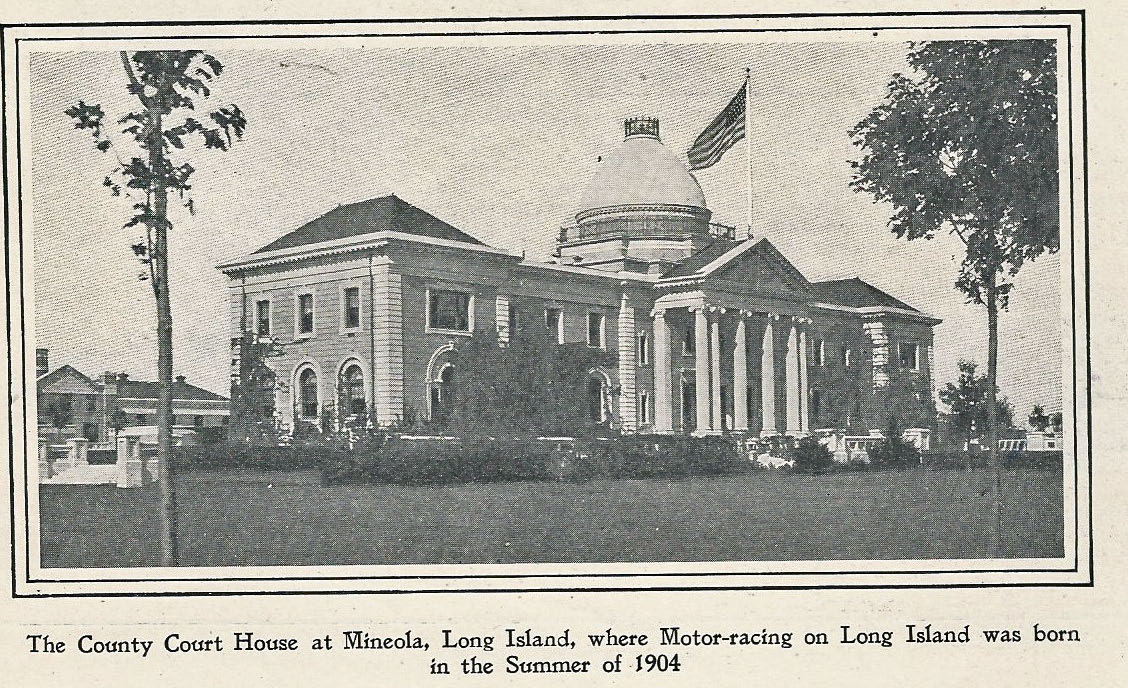
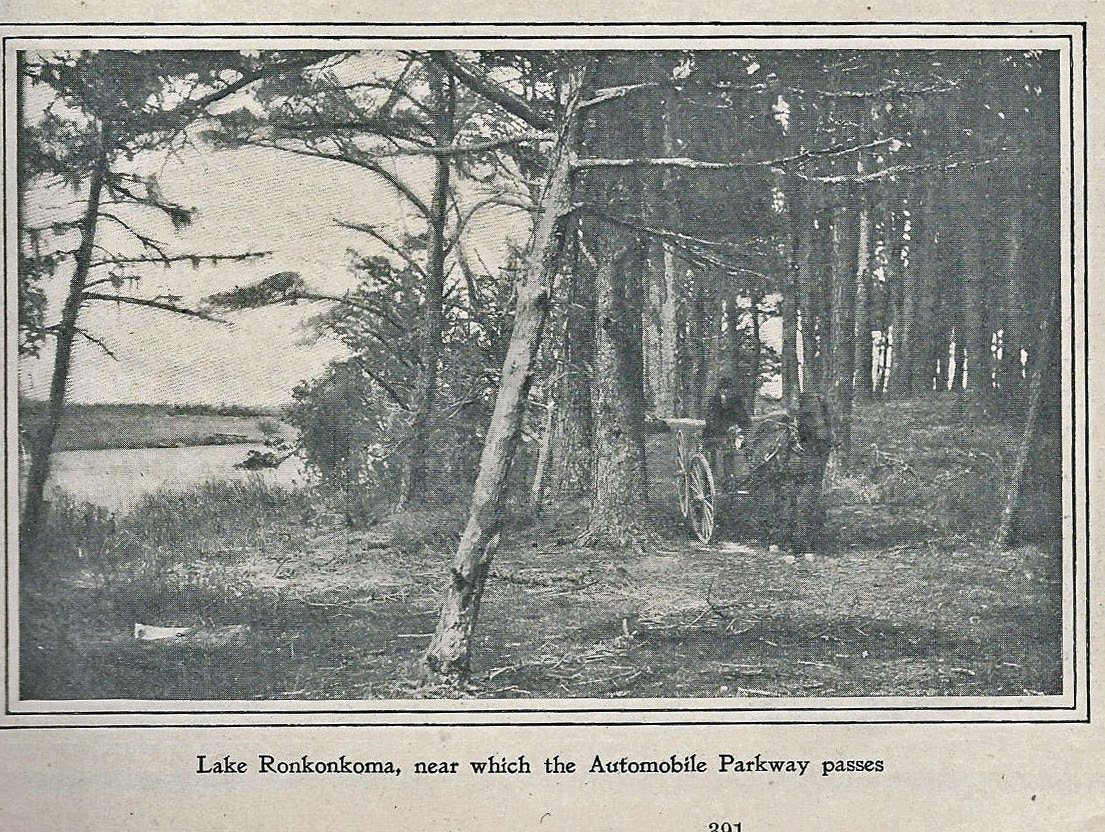
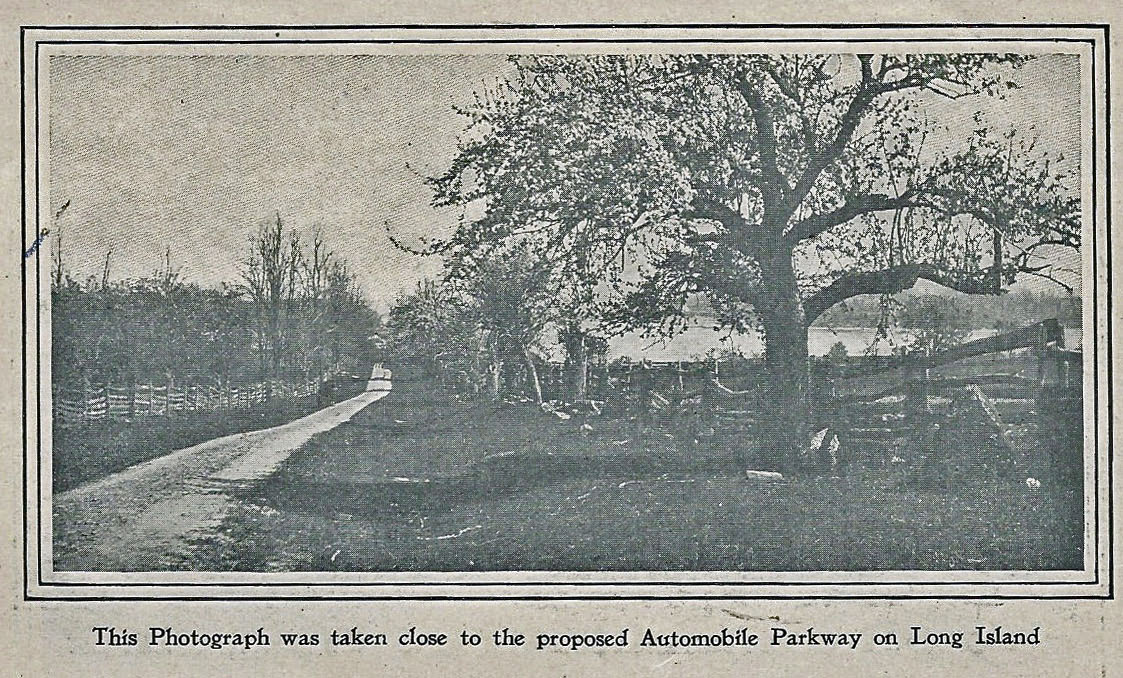
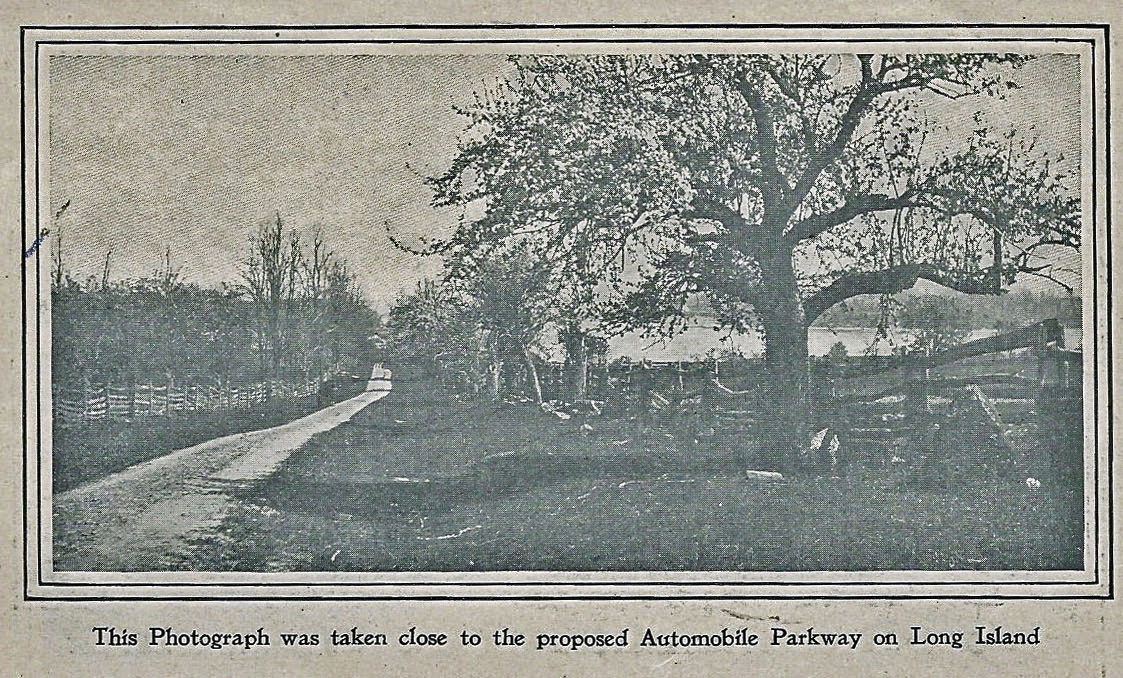
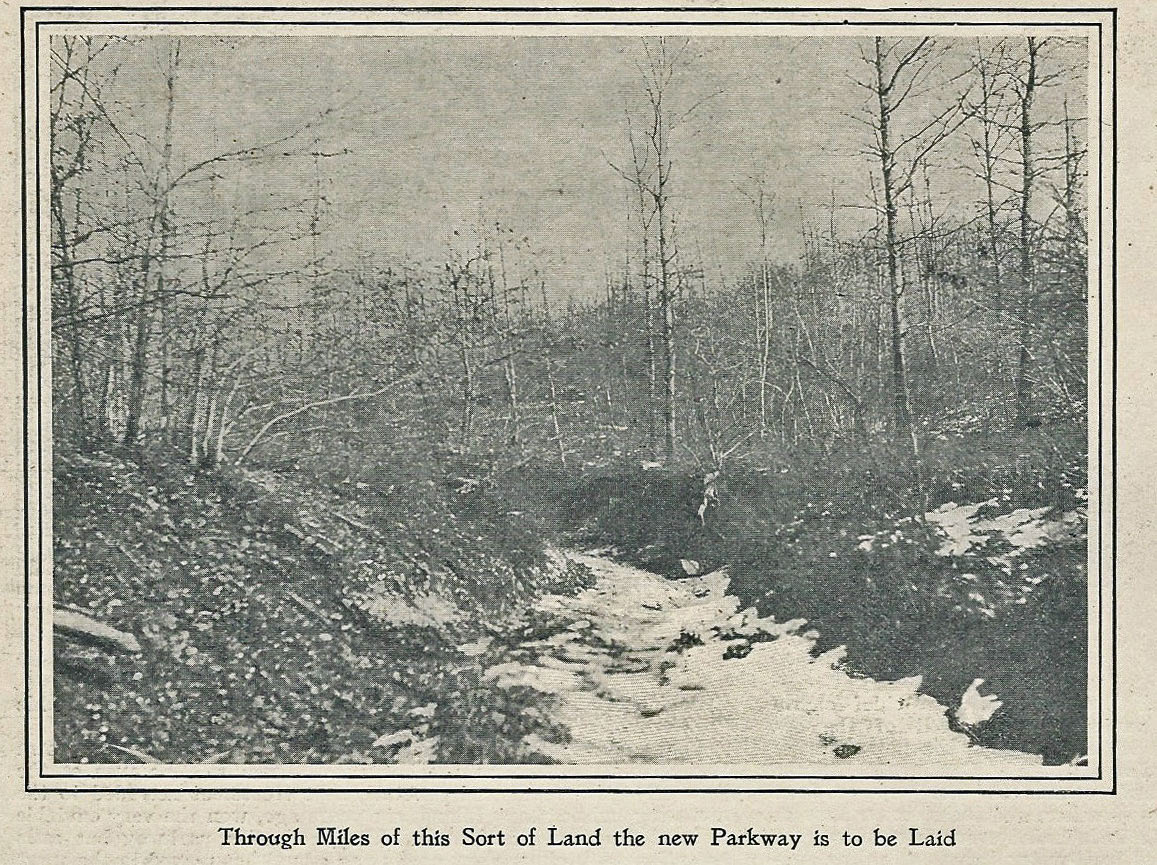
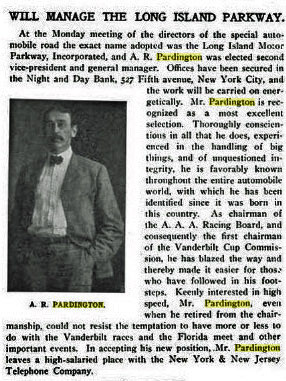
The Automobile November 22, 1906
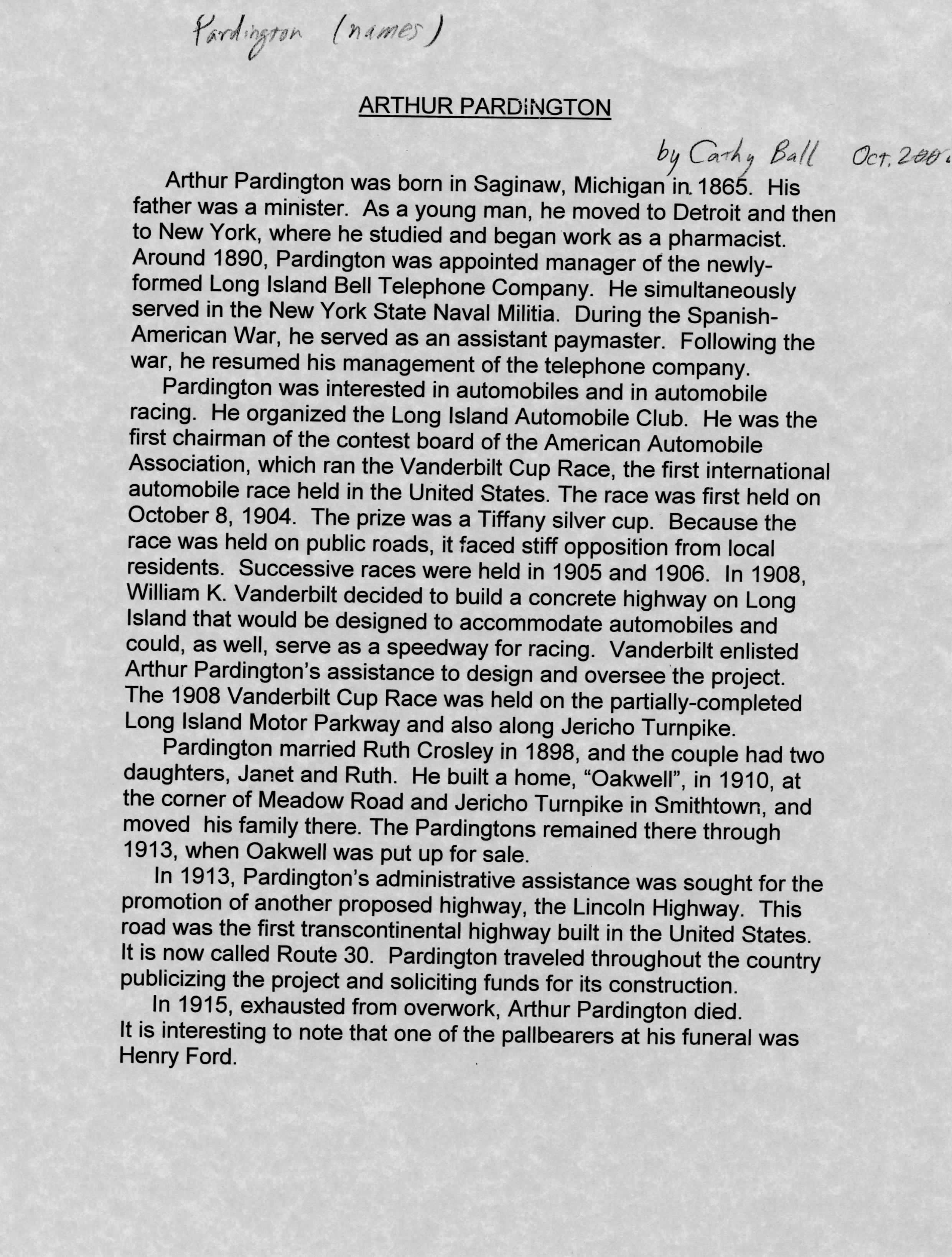
Arthur Pardington by Cathy Ball, Smithtown Public Library
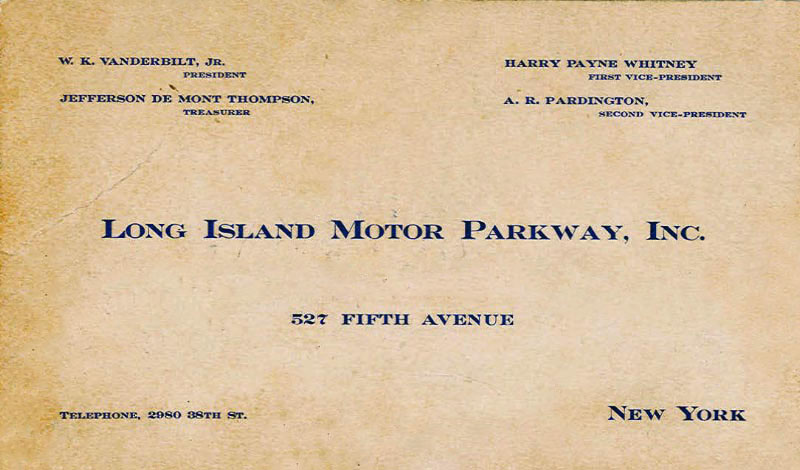
The official Motor Parkway business card.

Comments
Now that was a pitch if ever there were a pitch !!
Where did you find this stuff? Fantastic news of the Motor Parkway during its initial development. Blackwell Island is Roosevelt Island. There were unanticipated problems yet to come in the parkway’s design. A great historic piece in Long Island history that later served to develop better roadways throughout the city and suburbs.